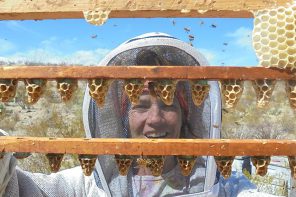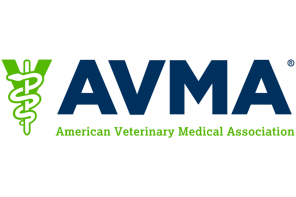Developing Accessible Apiaries
By: Adam Ingrao, Heroes to Hives & Ned Stoller, Michigan AgrAbility
If the goal in life is to live without risks, beekeeping should not enter a person’s career or hobby aspirations. Venomous insects, remotely located and difficult to access apiaries that are far from medical attention and days that require the lift-twist-bend repetition make the work of a beekeeper both daunting and dangerous. A person with a physical disability may not even imagine the potential to start an apiary or continue the work if faced with a physical limitation.
For the last decade, Heroes to Hives and Michigan AgrAbility have been working together to develop accessible technologies and recommendations for beekeepers with physical limitations. One outcome of the collaboration is the development of a Standard Operating Procedure (SOP) for Developing Accessible Apiaries. Not only does the SOP apply to physically limited beekeepers, it can also be a guide for anyone to reflect on the risks of apiary management and address operational weaknesses before an emergency or injury happens. The goal of this article is to provide a guide for building an accessible apiary, and help all beekeepers incorporate tools that will help them work smarter, not harder.
Planning
- One of the most important aspects of ensuring an apiary is accessible and can accommodate a variety of participant needs is planning. For educators, we recommend having participants register in advance for scheduled events and during the registration process you should ask those registering if they need any special accommodations. This allows you to prepare in advance if special equipment is needed and allows you to reach out to the individual to ensure you fully understand their needs. Examples of a question that can be included in an event registration are:
- Are there any special accommodations we can provide at this event to ensure this beekeeping experience meets your personal needs?
- Please let us know if you need accommodations to participate in this event. If so, we will reach out to you to discuss your personal needs.
- For individual beekeepers with physical limitations, planning is also an important part of a day in the apiary. Ensuring someone is aware of where you are going and how long you plan on being there can be an important safety measure that can support you if something happens. Additionally, ensuring you have a cell phone, two-way radio (when within range) or another communication device on you when in the apiary can be helpful to contact emergency support if an injury experienced in the apiary limits your mobility.
Support Team
-
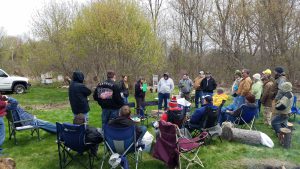
Figure 1. Photo credit: Adam Ingrao
When hosting individuals with accessibility needs at beekeeping events, it is important to ensure you have a proper support structure in place in case a participant requires attention, whether it be medical or personal support (Figure 1). Identifying an individual with emergency medical experience can be a great benefit to any beekeeping event and ensures that if a participant experiences a medical emergency, an individual is ready to jump in and support that individual immediately. Keep in mind, apiaries tend to be in remote locations that are not near medical facilities. Individuals that make great emergency support team members include:
- Firefighters / EMS
- Medical professionals: Doctors, nurses, etc.
- Mental health professionals
- Military Combat medics
- Beekeepers in personal apiaries that have physical limitations should try to work with a friend for support when possible. Support members can help with beekeeping activities but will also be an invaluable resource if the beekeeper experiences an injury or medical emergency.
Parking and Pathways
-
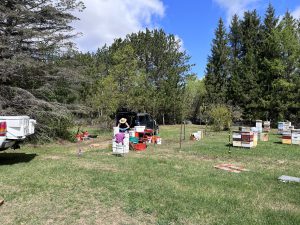
Figure 2. Photo credit: Adam Ingrao
Ensure that parking is in close proximity to the apiary, within a couple hundred feet, so that excessive walking is not required to get to the apiary site (Figure 2). Parking and walking paths should be on level, compacted surfaces that can accommodate vehicles and mobility devices, such as wheelchairs and walkers. If parking near the apiary is not possible, it is recommended that vehicle transport for individuals with mobility restrictions is provided to and from the apiary.
- In situations where vehicle access is not possible, or if you are a beekeeper with physical limitations working in a remote apiary, a well-outfitted cart or all-terrain utility vehicle is a great solution for managing off-road beehives and moving equipment to and from a remote apiary.
Apiary
- Selecting a proper apiary site is one of the most important aspects of developing an accessible apiary. Often, apiaries are in remote areas, far from medical attention, which makes them a risky place to be for individuals already facing physical restrictions. If an injury occurs in a remote apiary, medical attention may not be available for some time, which underscores the importance of a support team. By using the following criteria when selecting sites, you can avoid many common pitfalls that make apiaries inaccessible and/or dangerous to many with physical limitations. Following is a list of considerations that should be made for accessible apiaries:
-
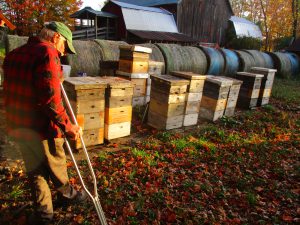
Figure 3. Photo credit: Bev Berens
Soil types should be considered when selecting an apiary site. Apiaries on heavy clay soils can become unusable for mobility devices if high moisture is present or rutting has occurred. High clay content soil surfaces should be avoided for accessible apiaries. High sand content soils may also be an issue for mobility devices if vegetation is not covering the surface to help stabilize the soil.
- Apiaries should be on flat, compacted surfaces or well-manicured grass to mitigate tripping hazards and accommodate mobility devices (Figure 3).
-
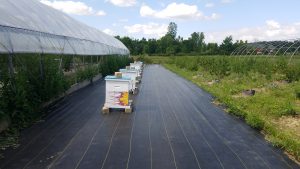
Figure 4. Photo credit: Adam Ingrao
Materials for compacted surfaces can include concrete, crushed concrete, rubber, milled asphalt, decking, compact gravel and weed exclusion cloth over a solid surface, or other materials that have been designed to support wheelchair and walker mobility in outdoor environments (Figure 4).
- Grass areas can be utilized for an apiary if they are consistently maintained and cut at a very low height (such as a fairway on a golf course).
- Note: all grass areas used should be cut with a bag attachment to collect grass debris. No grass debris should be present in an accessible apiary to prevent tripping hazards.
-
-
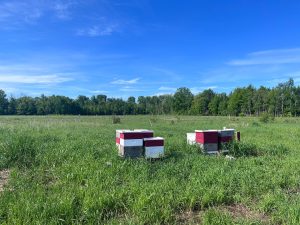
Figure 5. Photo credit: Adam Ingrao
Tripping hazards are one of the most dangerous aspects of an apiary (Figure 5). While working in an apiary, beekeepers are often carrying heavy equipment while moving about in a veil, which obscures vision. As a result, tripping hazards such as holes, stumps, rocks, tall grass, roots and weeds can cause severe injury. All tripping hazards should be removed or filled to ensure a safe, level surface to walk upon.
-
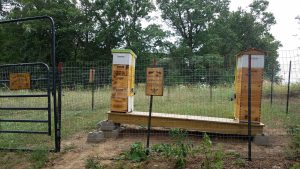
Figure 6. Photo credit: Adam Ingrao
Hive stands should be utilized to meet the needs of apiary users. Depending on the mobility restriction, hive stands can be as simple as cinder blocks that provide an eight inch lift, to custom stands that are engineered to support a comfortable working height for beekeepers (Figure 6).
- Variable hive styles can be incorporated into an apiary to meet the physical needs of beekeepers using the site. There are numerous manufactured and custom options available to support individuals with accessibility needs. The following is a short list of common hives that can be used in an accessible apiary and the limitations they may accommodate.
- AZ hives are one of the most useful hive designs for individuals with lifting restrictions or that are using a mobility device, such as a walker or wheelchair. The AZ hive offers the beekeeper the ability to work the hive from the rear, without having to lift hive bodies, and ensures that the most weight the beekeeper will have to work with is a single frame. Additionally, since AZ hives have a set height (no additional hive bodies are added) the hives can be positioned on stands that are designed to be at the best working height for the individual’s needs.
- Top bar or long hives are a style of hive that orients all frames on a horizontal plane so that no hive bodies are lifted. These hives can also be modified to articulate on their stand so that individuals can work the hive from a seated position. These hives work well for individuals with lifting restrictions or that are using a mobility device, such as a walker or wheelchair.
- Langstroth, and similarly vertically oriented hives, can be suitable for individuals with some mobility restrictions as long as the restrictions do not completely limit their ability to lift equipment. Langstroth hives require each hive body to be removed to inspect frames, which requires a lot of lifting (this can be supported with hive lifts). A couple accommodations to make Langstroth hives more accessible for those with some lifting restrictions are:
-
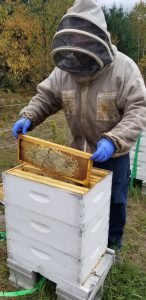
Figure 7. Photo credit: Adam Ingrao
Use eight frame hive bodies instead of 10 frame. This reduces the weight of each individual hive body by up to 15-20 lbs when full of honey.
- Use all medium hive bodies instead of deep hive bodies. Utilization of medium hive bodies can reduce the weight of the hive body by up to 15 lbs. Additionally, medium frames are easier to handle and inspect, especially for those suffering from arthritis or other mobility restrictions of the hands.
- It is highly recommended that accessible apiaries using Langstroth equipment use all eight frame medium equipment as this is the lightest combination of this style of equipment and is the most accessible arrangement for beekeepers using this hive style (Figure 7).
-
-
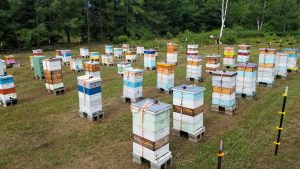
Figure 8. Photo credit: Adam Ingrao
Hives should be placed with at least five feet of clearance from other hives, in all cardinal directions, to ensure participants can get near the hives and that mobility devices, such as wheelchairs and walkers, can freely move between and around hives. Hives may be paired next to each other on stands if needed, as long as the area around the paired hives has five feet of clearance in all directions (Figure 8).
- All apiaries should have a first aid kit on site and an emergency action plan in place.
- First aid kits should include Epipens, band-aids, antiseptic, cooling cloths for heat exhaustion and water.
- Emergency action plans should identify:
- The closest emergency medical facility
- Local phone numbers for police, fire and EMS
- Where cell coverage is available to make emergency calls (if coverage is spotty or unavailable in the apiary)
- What support team member will provide care and transportation, if needed
- Description of the apiary site location for police, fire and EMS
- Emergency contact info for participants in apiary events
-
Apiary Facilities
-
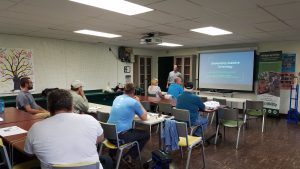
Figure 9. Photo credit: Adam Ingrao
Accessible apiaries require educational facilities that also accommodate the needs of participants. As such, restrooms and classrooms at any beekeeping event should meet the accessibility needs of all (Figure 9).
- An ADA accessible restroom should be present on site and in close proximity to the apiary. Restrooms must have at least 60 inches width and 56 inches depth of unobstructed clearance in the restroom with toilet seats 17-19 inches in height and support handles to accommodate movement from a wheelchair to a toilet seat. This can be a seasonal (portable toilet) or permanent facility.
- If a classroom is used for instruction, it should be ADA accessible with a door width of at least 32 inches. Tabletops should be no less than 28 inches and no more than 34 inches above the floor with 27 inches of knee clearance. Classrooms should be in close proximity to the apiary and restrooms.
- Potable water should be made available near the apiary or participants in apiary events should be notified ahead of time, in writing, that they should bring water to the event.
- Seating is encouraged to assist those who may not be able to stand for long periods of time. It is recommended that educators notify participants ahead of time that they will be standing for long periods and if needed they should bring a chair to sit in, as some individuals may desire to provide their own seating that supports their physical needs.
- Shade should be made available to individuals during field days to ensure sun exposure does not become an issue for those already working through physical limitations. Providing a canopy or a shaded tree line can provide relief when needed.
Liability Coverage (Important for educators)
- Regardless of the audience you are working with, ensuring proper insurance coverage for the activities you are conducting will protect you and your assets. Agritourism policies will oftentimes provide legal coverage for activities such as beekeeping classes. Consult with your insurance agent to ensure you are covered properly for the activities you are conducting.
- A waiver of liability developed for beekeeping activities should be signed by every individual entering the apiary. This should be a document drawn up by an attorney that clearly indicates the risks associated with beekeeping and the proper language to protect you and your assets from liability if an accident occurs in the apiary.
- Signage should be displayed around the apiary and should clearly state the risks associated with working in an apiary.
- If you plan on taking pictures and using images of individuals participating in apiary activities, it is recommended to have participants sign media waivers to ensure proper permission for use of images. This is especially important when working with individuals with physical limitations.
Keeping bees can be rewarding, satisfying and enjoyable. By creating spaces that incorporate accessibility, beekeepers open doors for more people to join, enjoy and find success within the industry and enjoy the gifts our bees give us!






